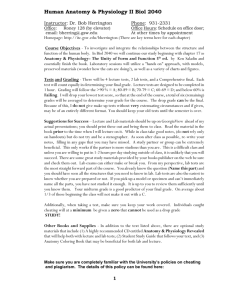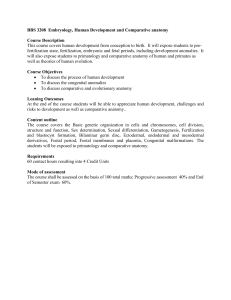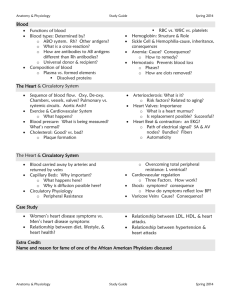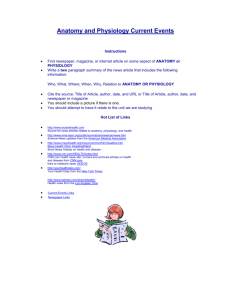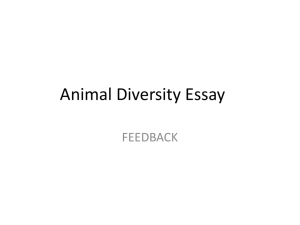Study Guide for Animal Physiology Exam (Part B of Final Exam)
advertisement
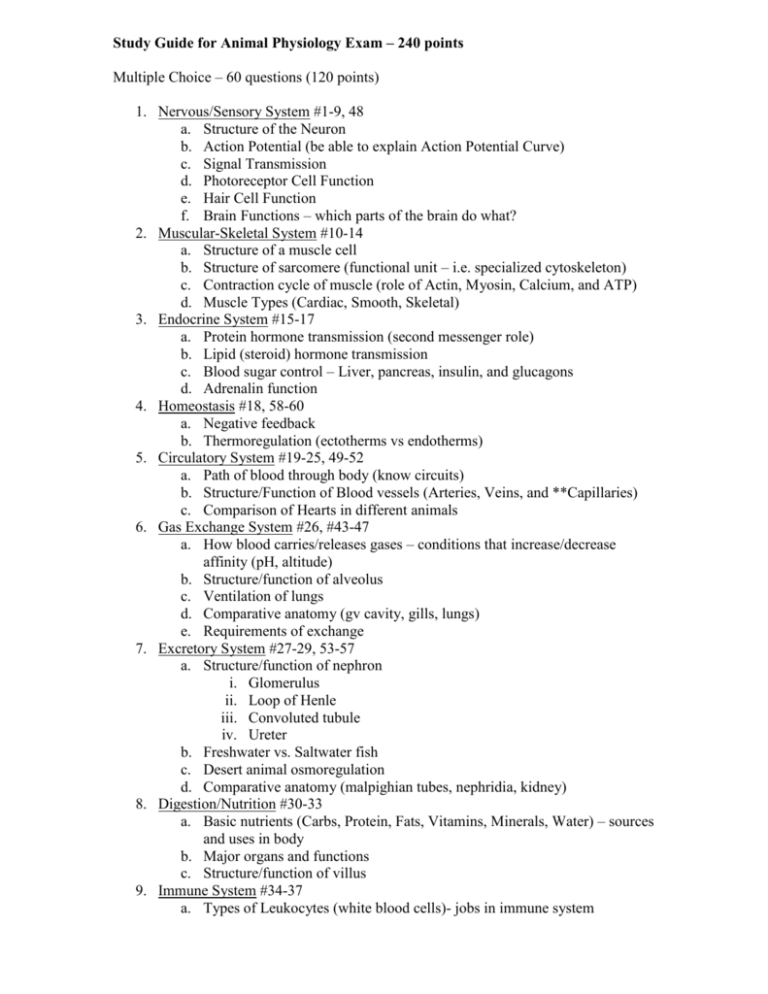
Study Guide for Animal Physiology Exam – 240 points Multiple Choice – 60 questions (120 points) 1. Nervous/Sensory System #1-9, 48 a. Structure of the Neuron b. Action Potential (be able to explain Action Potential Curve) c. Signal Transmission d. Photoreceptor Cell Function e. Hair Cell Function f. Brain Functions – which parts of the brain do what? 2. Muscular-Skeletal System #10-14 a. Structure of a muscle cell b. Structure of sarcomere (functional unit – i.e. specialized cytoskeleton) c. Contraction cycle of muscle (role of Actin, Myosin, Calcium, and ATP) d. Muscle Types (Cardiac, Smooth, Skeletal) 3. Endocrine System #15-17 a. Protein hormone transmission (second messenger role) b. Lipid (steroid) hormone transmission c. Blood sugar control – Liver, pancreas, insulin, and glucagons d. Adrenalin function 4. Homeostasis #18, 58-60 a. Negative feedback b. Thermoregulation (ectotherms vs endotherms) 5. Circulatory System #19-25, 49-52 a. Path of blood through body (know circuits) b. Structure/Function of Blood vessels (Arteries, Veins, and **Capillaries) c. Comparison of Hearts in different animals 6. Gas Exchange System #26, #43-47 a. How blood carries/releases gases – conditions that increase/decrease affinity (pH, altitude) b. Structure/function of alveolus c. Ventilation of lungs d. Comparative anatomy (gv cavity, gills, lungs) e. Requirements of exchange 7. Excretory System #27-29, 53-57 a. Structure/function of nephron i. Glomerulus ii. Loop of Henle iii. Convoluted tubule iv. Ureter b. Freshwater vs. Saltwater fish c. Desert animal osmoregulation d. Comparative anatomy (malpighian tubes, nephridia, kidney) 8. Digestion/Nutrition #30-33 a. Basic nutrients (Carbs, Protein, Fats, Vitamins, Minerals, Water) – sources and uses in body b. Major organs and functions c. Structure/function of villus 9. Immune System #34-37 a. Types of Leukocytes (white blood cells)- jobs in immune system i. Macrophages ii. T-cells 1. Helper T 2. Cytotoxic T iii. B-cells 1. Antibodies’ job b. HIV 10. Development #38-40 a. Order of development from 2 cell neurula b. Define Blastula, Gastrula, and Stem Cell c. Determination of ectoderm, mesoderm, endoderm 11. Evolutionary Trends #41-42 a. Trends in evolution of absorptive structures Matching (Diagrams) – 40 question (80 points) 12. Digestive System #61-70 13. Sensory Organs #71-76 14. Heart #77-85 15. Excretory System #86-90 16. Brain #91-97 17. Muscles #98-100 Free Response (40 points) 18. Physiology of the Circulatory System Lab (effect of exercise on circulation; homeostasis) 19. Comparative Anatomy a. Gas exchange and ventilation in cnidarians, arthropods, fish, amphibians, birds and humans (#41-46) b. Balance in fish vs. mammals (#47) c. Hearts of fish, amphibians/reptiles, mammals/birds/crocodilians (#48-51) d. Excretion in annelids, arthropods, humans (#52-53) e. Osmoregulation in freshwater/saltwater fish; desert/non-desert animals (#54-56) f. Brain/Nervous System Evolution in Vertebrates (#57) g. Thermoregulation in Endotherms vs. Ectotherms (#58-60) 20. Human Gross Anatomy (61 – 85) a. Be able to identify organs and structures from the following: i. Digestive System ii. Inner Ear iii. Eye iv. Skeletal System v. Circulatory System vi. Gas Exchange System Free Response Section – 2 questions (80 points) Structure vs. Function (functional units of systems) Comparative Anatomy (Cnidaria vs. Annelida vs. Chordata) Physiology of the Circulatory System (also interactions of nervous, respiratory and circulatory system)
